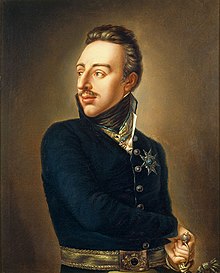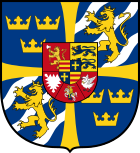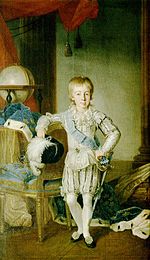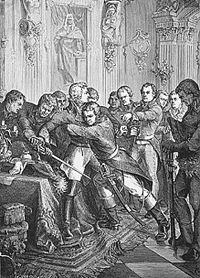Gustav IV Adolf
This article needs additional citations for verification. (February 2022) |
| Gustav IV Adolf | |
|---|---|
 Portrait by Per Krafft the Younger, 1809 | |
| King of Sweden | |
| Reign | 29 March 1792 – 29 March 1809 |
| Coronation | 3 April 1800 |
| Predecessor | Gustav III |
| Successor | Charles XIII |
| Regent | Charles, Duke of Södermanland (later Charles XIII) (1792–1796) |
| Born | 1 November 1778 Stockholm Palace, Kingdom of Sweden |
| Died | 7 February 1837 (aged 58) St. Gallen, Swiss Confederacy |
| Burial | 29 May 1884 |
| Spouse | |
| Issue | |
| House | Holstein-Gottorp |
| Father | Gustav III |
| Mother | Sophia Magdalena of Denmark |
| Religion | Lutheran |
| Signature |  |
| Swedish royalty |
| House of Holstein-Gottorp |
|---|
 |
| Adolf Frederick |
| Gustav III |
| Gustav IV Adolf |
|
| Charles XIII |
|
Gustav IV Adolf or Gustav IV Adolph[1] (1 November 1778 – 7 February 1837) was King of Sweden from 1792 until he was deposed in a coup in 1809. He was also the last Swedish monarch to be the ruler of Finland.
The occupation of Finland in 1808–09 by Russian forces was the immediate cause of Gustav Adolf's overthrow, violently initiated by officers of his own army. Following his abdication on 29 March 1809, an Instrument of Government was hastily written, which severely circumscribed the powers of the monarchy. The "Instrument" was adopted in 1809 on 6 June, the National Day of Sweden now as well as in his time. It remained in force until replaced in 1974. The crown, now with strictly limited powers, passed to Gustav Adolf's uncle Charles XIII.[2]
Early life
[edit]
Gustav Adolf was born in Stockholm. He was the son of Gustav III by his wife queen Sophia Magdalena. His mother, Sophia Magdalena, was eldest daughter of Frederick V of Denmark and his first wife Louise of Great Britain.
Gustav Adolf was under the tutelage of Hedvig Sofia von Rosen and her deputies Brita Ebba Celestina von Stauden and Maria Aurora Uggla until the age of four. He was then raised under the tutelage of his father and the liberal-minded Nils von Rosenstein. Upon Gustav III's assassination in March 1792, Gustav Adolf succeeded to the throne at the age of 13, under the regency of his uncle, Prince Charles, Duke of Södermanland, who was later to become King Charles XIII when his nephew was forced to abdicate and was banished from the country in 1809.
In August 1796, his uncle the regent arranged for the young king to visit Saint Petersburg. The intention was to arrange a marriage between the young king and Grand Duchess Alexandra Pavlovna, a granddaughter of Catherine the Great. However, the whole arrangement foundered on Gustav Adolf's unwavering refusal to allow his intended bride liberty of worship according to the rites of the Russian Orthodox Church. Nobody seems to have suspected the possibility at the time that emotional problems might lie at the root of Gustav Adolf's abnormal piety. On the contrary, when he came of age that year, thereby ending the regency, there were many who prematurely congratulated themselves on the fact that Sweden had now no disturbing genius, but an economical, God-fearing, commonplace monarch.[3]
Politics
[edit]Gustav Adolf's prompt dismissal of the generally detested Gustaf Adolf Reuterholm, the duke-regent's leading advisor, added still further to his popularity. On 31 October 1797 Gustav married Friederike Dorothea, granddaughter of Karl Friedrich, Margrave of Baden, a marriage which seemed to threaten war with Russia but for the fanatical hatred of the French republic shared by the Emperor Paul of Russia and Gustav IV Adolf, which served as a bond between them. Indeed, the king's horror of Jacobinism was intense, and drove him to become increasingly committed to the survival of Europe, to the point where he postponed his coronation for some years, so as to avoid calling together a diet. Nonetheless, the disorder of the state finances, largely inherited from Gustav III's war against Russia, as well as widespread crop failures in 1798 and 1799, compelled him to summon the estates to Norrköping in March 1800 and on 3 April the same year.[3] When the king encountered serious opposition at the Riksdag, he resolved never to call another.
Loss of Finland
[edit]His reign was ill-fated and was to end abruptly. In 1805, he joined the Third Coalition against Napoleon. His campaign went poorly and the French occupied Swedish Pomerania. When his ally, Russia, made peace and concluded an alliance with France at Tilsit in 1807, Sweden and Portugal were left as Great Britain's only allies on the European continent. On 21 February 1808, Russia invaded Finland, which was ruled by Sweden, on the pretext of compelling Sweden to join Napoleon's Continental System. Denmark likewise declared war on Sweden.[citation needed] In just a few months, almost all of Finland was lost to Russia. As a result of the war, on 17 September 1809, in the Treaty of Fredrikshamn, Sweden surrendered the eastern third of Sweden to Russia. Following which the autonomous Grand Duchy of Finland was established within Imperial Russia.
Coup d'état and abdication
[edit]
Gustav Adolf was deposed by a conspiracy of army officers.
On 7 March 1809, lieutenant-colonel Georg Adlersparre, commander of a part of the so-called western army stationed in Värmland, triggered the Coup of 1809 by raising the flag of rebellion in Karlstad and starting to march upon Stockholm. To prevent the king from joining loyal troops in Scania, on 13 March 1809 seven of the conspirators led by Carl Johan Adlercreutz broke into the royal apartments in the palace, seized the king, and imprisoned him and his family in Gripsholm Castle; the king's uncle, Duke Charles (Karl), accepted the leadership of a provisional government, which was proclaimed the same day; and a diet, hastily summoned, solemnly approved of the revolution.[3]
On 29 March Gustav IV Adolf, to save the crown for his son, voluntarily abdicated; but on 10 May the Riksdag of the Estates, dominated by the army, declared that not merely Gustav but his whole family had forfeited the throne,[3] perhaps an excuse to exclude his family from succession based on the rumours of his illegitimacy. A more likely cause, however, is that the revolutionaries feared that Gustav Adolf's son, if he inherited the throne, would avenge his father's deposition when he came of age. On 5 June, Gustav Adolf's uncle was proclaimed King Charles XIII, after accepting a new liberal constitution, which was ratified by the diet the next day. In December, Gustav Adolf and his family were transported to Germany. In 1812, he divorced his wife.
In exile Gustav Adolf used several titles, including Count Gottorp and Duke of Holstein-Eutin, and finally settled at St. Gallen in Switzerland where he lived in a small hotel in great loneliness and indigence,[3] under the name of Colonel Gustafsson. It was there that he suffered a stroke and died. He was buried in Moravia. At the suggestion of King Oscar II and Norway his body was finally brought to Sweden and interred in Riddarholm Church. Gustav Adolf was a great-grandfather of Victoria of Baden, Oscar's new daughter-in-law at the time and eventually Queen of Sweden as consort to Oscar's son Gustaf V.
Arms
[edit] Coat of arms of King Gustav IV Adolf
|
Ancestry
[edit]| Ancestors of Gustav IV Adolf |
|---|
Family
[edit]

In 1797 he married Frederica Dorothea Wilhelmina of Baden, with whom he had five children:
- Crown Prince Gustav, after 1809 known as Gustaf Gustafsson, Prince of Vasa (9 November 1799 – 1877). He served as an officer in the service of the Habsburgs of Austria, and with his wife Princess Louise Amelie of Baden, fathered a son who died in infancy, and a daughter, Carola, the wife of Albert, King of Saxony. She died childless.
- Princess Sofia Wilhelmina (21 May 1801 – 1865). She married Grand Duke Leopold of Baden, and their granddaughter Victoria of Baden married the Bernadotte king Gustaf V. (The present King Carl XVI Gustaf is thus a descendant of Gustav IV.)
- Prince Carl Gustaf, Grand Duke of Finland (2 December 1802 – 10 September 1805)
- Princess Amalia (22 February 1805 – 31 August 1853); unmarried and without issue
- Princess Cecilia (22 June 1807 – 1844); married Augustus, Grand Duke of Oldenburg, and had issue.
By 1812, Gustav Adolf divorced his consort, and following this he had several mistresses, among them Maria Schlegel, who gave him a son, Adolf Gustafsson.
See also
[edit]Notes
[edit]References
[edit]- H. Arnold Barton, Scandinavia in the Revolutionary Era, 1760–1815, 1986, ISBN 0-8166-1392-3.
- Sten Carlsson, Gustaf IV Adolf, 1946.
- This article incorporates text from a publication now in the public domain: Bain, Robert Nisbet (1911). "Gustavus IV.". In Chisholm, Hugh (ed.). Encyclopædia Britannica. Vol. 12 (11th ed.). Cambridge University Press. p. 738.
External links
[edit]- . New International Encyclopedia. 1905.
- . The American Cyclopædia. 1879.
- 1778 births
- 1837 deaths
- 18th-century Swedish monarchs
- 19th-century Swedish monarchs
- Monarchs who abdicated
- People from Stockholm
- Crown princes of Sweden
- House of Holstein-Gottorp
- Child monarchs
- Swedish monarchs of German descent
- Burials at Riddarholmen Church
- Sons of kings
- Royal reburials
- Leaders ousted by a coup

